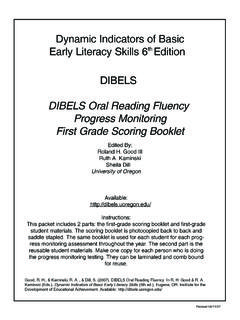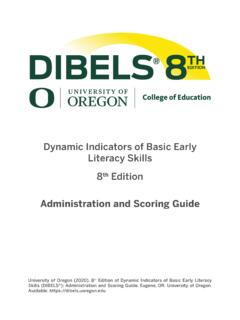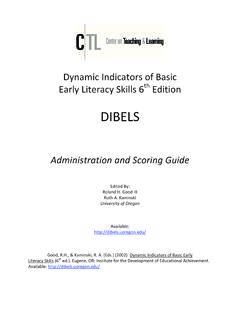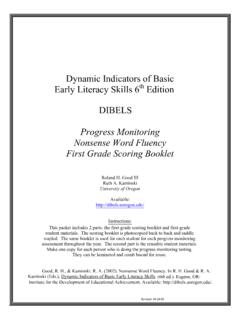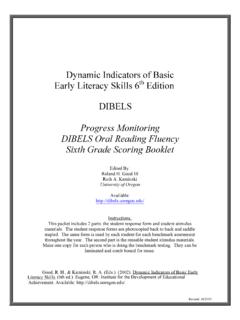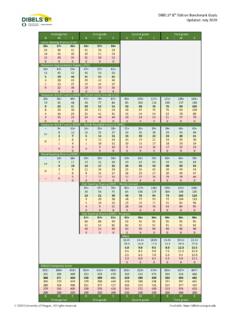Transcription of DIBELS 8th Edition Composite Score Calculation Guide ...
1 dynamic indicators of basic early literacy Skills 8th Edition Composite Score Calculation Guide SupplementJuly 2020 University of Oregon (2020). 8th Edition of dynamic indicators of basic early literacy Skills ( DIBELS ): Composite Score Calculation Guide Supplement. Eugene, OR: University of Oregon. Available: AuthorsGina Biancarosa, Ed. D. Associate Professor and Ann Swindells Chair in Education Department of Educational Methodology, Policy, and LeadershipCollege of Education, University of OregonPatrick C. Kennedy, Research Associate and Director of Data Management and Analysis Group Center on Teaching & LearningCollege of Education, University of OregonSunhi ParkGraduate Research Assistant FellowCenter on Teaching & LearningCollege of Education, University of OregonJanet Otterstedt, Assistant and Project CoordinatorCenter on Teaching & LearningCollege of Education, University of OregonBrian Gearin, Assistant and Project CoordinatorCenter on Teaching & LearningCollege of Education, University of OregonChristopher IvesGraduate Research Assistant FellowCenter on Teaching & LearningCollege of Education, University of OregonContributing EditorsMaureen Warman.
2 Senior Research Assistant I and DIBELS Data System Manager Center on Teaching & LearningCollege of Education, University of OregonUniversity of Oregon would also like to acknowledge and thank our partner Amplify Education for their work on copy editing and .. 4 Discontinue and Gating Rules Composite Score Calculation .. 5 Composite Score Calculation Worksheets .. 10 Table of ContentsComposite Score Calculation Guide Supplement4 | DIBELS 8th Edition 2020 University of Oregon. All rights This document supplements the DIBELS 8th Edition Administration and Scoring Guide . The Administration and Scoring Guide contains in depth information about the DIBELS 8th Edition Composite Score and includes an Appendix with values for all grades K-8.
3 The Administration and Scoring Guide can be downloaded from the DIBELS Materials supplement includes special instructions for use when calculating a Composite Score in cases where discontinue and gating rules are utilized. This Guide also includes Composite Score Calculation worksheets that can be used to manually calculate the Composite Score . DIBELS 8th Edition | 5 Composite Score Calculation Guide Supplement 2020 University of Oregon. All rights and Gating Rules Composite Score Calculation Special rules apply to calculate the DIBELS 8 Composite Score when a discontinue or gating rule has been used and a student has not been administered all available subtests for their grade.
4 In these cases a constant is used in place of the missing raw scores. The steps are the same as when calculating a regular Composite Score with the additional step of substituting a constant for the missing values. Example calculations are provided after the tables on the following pages. Discontinue RulesThere are three discontinue rules that impact Calculation of a Composite Score . In all cases, when a measure is discontinued a Score of zero is given for that measure and the remaining measures are not administered. Grade K: Beginning of Year (BOY) - If PSF is discontinued, do not administer NWF and WRF. Enter zero for PSF. Do not enter scores for the remaining subtests: NWF and K: Middle of Year (MOY) - If NWF is discontinued, do not administer WRF.
5 Enter zero for NWF. Do not enter scores for the remaining subtest: 1: Beginning of Year (BOY) - If WRF is discontinued, do not administer ORF. Enter zero for WRF. Do not enter scores for the remaining subtest: ORFG ating RulesThere are eight time periods across three grades where a gating rule impacts Calculation of a Composite Score . In these cases, when a measure is not given because a student's scores are in the blue negligible risk category on the specified measures, a constant value can be used to calculate a Composite Score . Grade 1: Middle of Year (MOY) and End of Year (EOY) - If the student scores in the blue range on NWF-CLS, then you do not have to administer LNF or PSF.
6 Leave those scores blank if not 2 and 3: Beginning of Year (BOY), Middle of Year (MOY), and End of Year (EOY) - If the student scores in the blue range on ORF-WRC, then you do not have to administer NWF or WRF. Leave those scores blank if not administered. Always give Score Calculation Guide Supplement6 | DIBELS 8th Edition 2020 University of Oregon. All rights the following steps, in order:1. For each subtest raw Score , multiply the student s raw Score by the Weight listed in the table on the next page, rounding the result to the 100ths a student does not have a subtest raw Score due to the Discontinue or Gating Rules, use the constant from the table below for the missing subtest scores.
7 2. Sum the resulting weighted scores across all applicable From that sum, subtract the Mean for the appropriate grade from the table on the next Divide the result by the standard deviation (SD) for the appropriate grade in the table on the next page and round to the 100ths Multiply the result by 40 and round to the ones Add the scaling constant corresponding to the grade and season in which the student was tested from the table on the next page. The result is the Composite that ORF Accuracy should be represented in these calculations as a proportion of words correct ( , .99), rather than percent correct ( , 99). Composite Score constants for use when discontinuing or gating benchmarkingGradeTime PeriodLNFPSFNWF CLS NWF WRC WRFORF WRCORF ACCD iscontinueKindergartenBOY (fall)000 MOY (winter)0 FirstBOY (fall)00 GatingFirstMOY (winter)6656 EOY (spring)6860 SecondBOY (fall)852449 MOY (winter)1023562 EOY (spring)1163869 ThirdBOY (fall)1203359 MOY (winter)1374564 EOY (spring)
8 1404469 DIBELS 8th Edition | 7 Composite Score Calculation Guide Supplement 2020 University of Oregon. All rights Score Calculation Values K-3 GradeSubtest scoreWeightMeanSDFall constant Winter constantSpring constantKindergarten LNF Score Calculation Guide Supplement8 | DIBELS 8th Edition 2020 University of Oregon. All rights Example For a kindergarten student with Beginning of Year (BOY/fall) DIBELS 8 scores of 10 for LNF, 0 for PSF, and no scores for NWF-CLS, NWF-WRC, or WRF due to the discontinue rule, we would calculate this student s Composite Score as follows.
9 Step 1: Multiply each subtest raw Score by the corresponding weight listed in the table. Use a zero for the missing subtest/s Score /s. Subtest scoreRaw scoreWeightWeight * * * * * 2: Sum the resulting weighted scores across all applicable subtests: + + + + = 3: Subtract from that sum the mean of the weighted scores for the appropriate 729 = 4: Divide that value by the standard deviation for the appropriate grade: / 630 = 5: Multiply that Score by 40 and round to the ones place: * 40 = -24 Step 6: Add the scaling constant corresponding to the season in which the student was tested to obtain the final Composite Score :-24 + 289 = 265 DIBELS 8th Edition | 9 Composite Score Calculation Guide Supplement 2020 University of Oregon.
10 All rights Example For a second grade student with Beginning of Year (BOY/fall) DIBELS 8 scores of 93 for ORF-WRC, (99%) ORF-ACC, for Maze Adjusted, and no scores for NWF-CLS, NWF-WRC, or WRF due to the gating rule, we would calculate this student s Composite Score as follows. Step 1: Multiply each subtest raw Score by the corresponding weight listed in the table. Use the constant values for the missing subtest/s Score /s. Subtest scoreRaw scoreWeightWeight scoreNWF-CLS85* * * * * * 2: Sum the resulting weighted scores across all applicable subtests: + + + + + = 3: Subtract from that sum the mean of the weighted scores for the appropriate 7085 = 4: Divide that value by the standard deviation for the appropriate grade: / 3811 = 5: Multiply that Score by 40 and round to the ones place: * 40 = 4 Step 6: Add the scaling constant corresponding to the season in which the student was tested to obtain the final Composite Score :4 + 360 = 364 Composite Score Calculation Guide Supplement10 | DIBELS 8th Edition 2020 University of Oregon.
